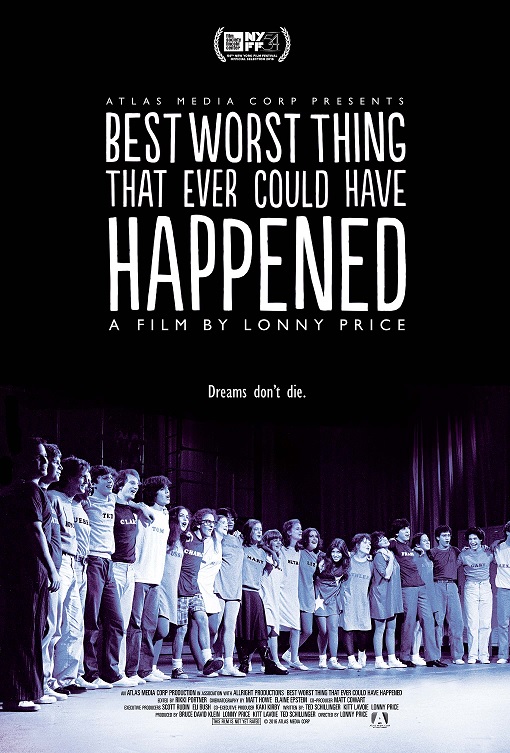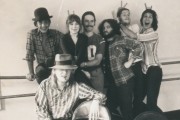 In 1981, Stephen Sondheim and Hal Prince were firmly established as one of the most successful songwriter-producer/director partnership in Broadway history. Together the pair collaborated on hit after hit — West Side Story (1957), A Funny Thing Happened on the Way to the Forum (1962), Company (1970), Follies (1971), A Little Night Music (1973), Pacific Overtures (1976), and Sweeney Todd (1979). But 1981’s Merrily We Roll Along, which was cast entirely by rookie Broadway performers between the ages of 16 and 25, was a critical and commercial failure. It not only ended the duo’s partnership, but it left the younger actors who starred in the show — all of whom were thrilled to be part of a Sondheim/Prince musical — devastated. One of those actors, Lonny Price, grew up to be an acclaimed director of theater and actor and has created Best Worst Thing That Ever Could Have Happened, a documentary chronicling the creation, failure, and shocking successful revival of Merrily We Roll Along, as well as what happened in the lives of the original cast afterwards.
In 1981, Stephen Sondheim and Hal Prince were firmly established as one of the most successful songwriter-producer/director partnership in Broadway history. Together the pair collaborated on hit after hit — West Side Story (1957), A Funny Thing Happened on the Way to the Forum (1962), Company (1970), Follies (1971), A Little Night Music (1973), Pacific Overtures (1976), and Sweeney Todd (1979). But 1981’s Merrily We Roll Along, which was cast entirely by rookie Broadway performers between the ages of 16 and 25, was a critical and commercial failure. It not only ended the duo’s partnership, but it left the younger actors who starred in the show — all of whom were thrilled to be part of a Sondheim/Prince musical — devastated. One of those actors, Lonny Price, grew up to be an acclaimed director of theater and actor and has created Best Worst Thing That Ever Could Have Happened, a documentary chronicling the creation, failure, and shocking successful revival of Merrily We Roll Along, as well as what happened in the lives of the original cast afterwards.
Sondheim and Prince had dominated Broadway throughout the 1970s, and in some cases with off-beat, less-than-traditional work. After all, Pacific Overtures is about the Westernization of Japan, while Sweeney Todd is about a mass-murdering barber. Yet Merrily We Roll Along would arguably be the duo’s most ambitious project yet — a musical version of the 1934 play of the same name that tells the story of jaded, unfulfilled adults in reverse order — they start in middle-age and the story is told backwards to their high school graduation. Sondheim and Prince held a casting call in New York that drew thousands of young actors who desperately wanted to star in the duo’s new collaboration. Fortunately, the casting process was extensively documented by ABC for a news segment that never aired (that footage is used in this film).
But as the old saying goes, once you hit the top there’s only one direction you can go. Merrily We Roll Along had issues, from casting, costuming, and production values — and audiences and critics were turned off by the reverse-chronological order of the story. During the longer-than-usual previews Sondheim and Prince tried to fix the show, including replacing the original lead actor, James Weissenbach, with future Broadway regular Jim Walton, after 2 weeks. But nothing worked — the show closed after 52 previews and 16 performances. Sondheim and Prince would not collaborate together again for nearly 25 years.
While Best Worst Thing That Ever Could Have Happened recalls the genesis and troubled production of Merrily We Roll Along, the focus is really on what happened afterward. Few members of the young cast continued with acting, with several remarking that the experience destroyed their confidence or set their expectations too high. Of all those involved, the most famous is Jason Alexander, who (of course) went on to play George on Seinfeld. Yet even he points out that fame and fortune is not all its cracked up to be — being a star means taking time away from your family, means he’s always expected to be “George” in public, and, perhaps toughest of all, means that he has had difficult replicating his success post-Seinfeld (Bob Patterson, anyone?). Still, all of the cast members speaking glowingly of their time involved in the show, even if they moved on from acting afterward.
As any musical theater fan likely knows, the story of Merrily We Roll Along didn’t end with the failed 1981 Broadway production. It’s taken on new life in countless amateur and professional productions ever since, and Best Worst Thing That Ever Could Have Happened follows that journey, too. But the fact that Price is so close to this material is both the biggest strength and weakness of the documentary — while Price is somewhat critical of the original production, he isn’t critical enough. The archive footage of the original production shows that the musical just wasn’t ready for the Broadway stage — with some of the footage being simply cringe-inducing (the “costumes,” which consist of sweatshirts, are awful). It’s no surprise that the production found more success on smaller stages — and the documentary doesn’t mention that Sondheim has revised the musical several times, which has also contributed to the success of subsequent productions. It’s probably difficult for Price to be completely honest about the obvious problems with the original production because of his intimate association with it — a more objective eye would’ve been better here.
Musical theater fans will doubtless enjoy this peak behind the curtain at the making and aftermath of one of Broadway’s most notorious flops. The will have to accept the fact that this documentary isn’t an objective look at the failure and instead a celebration of what could have been, but they will doubtlessly find a lot to enjoy.

















Recent Comments